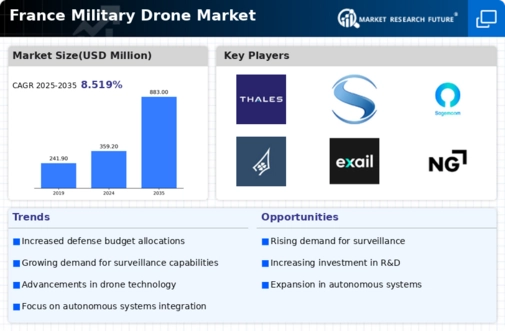The military drone market in France is characterized by a dynamic competitive landscape, driven by technological advancements and increasing defense budgets. Key players such as Thales Group (FR), General Atomics (US), and Northrop Grumman (US) are at the forefront, each adopting distinct strategies to enhance their market positioning. Thales Group (FR) focuses on innovation and local partnerships, leveraging its expertise in avionics and sensors to develop advanced drone systems tailored for the French military. Meanwhile, General Atomics (US) emphasizes international collaborations, particularly in Europe, to expand its operational footprint and enhance its product offerings. Northrop Grumman (US) is investing heavily in digital transformation, integrating AI and machine learning into its drone systems, which positions it favorably in a market increasingly reliant on advanced technologies.
The business tactics employed by these companies reflect a concerted effort to localize manufacturing and optimize supply chains, which is crucial in a moderately fragmented market. The competitive structure is shaped by the presence of both established defense contractors and emerging players, creating a landscape where innovation and strategic partnerships are paramount. This fragmentation allows for a diverse range of products and services, catering to various military needs while fostering healthy competition among key players.
In October 2025, Thales Group (FR) announced a strategic partnership with a leading European aerospace firm to co-develop next-generation drone technologies. This collaboration is expected to enhance Thales's capabilities in autonomous systems, aligning with the French military's focus on increasing operational efficiency and reducing costs. The partnership signifies a shift towards collaborative innovation, which may redefine competitive dynamics in the market.
In September 2025, General Atomics (US) secured a contract with the French Ministry of Defense to supply advanced surveillance drones. This contract not only underscores General Atomics's commitment to the European market but also highlights the growing demand for sophisticated surveillance capabilities among European defense forces. The strategic importance of this contract lies in its potential to solidify General Atomics's presence in France, paving the way for future collaborations and technology transfers.
In August 2025, Northrop Grumman (US) launched a new drone model equipped with cutting-edge AI capabilities, aimed at enhancing battlefield intelligence. This launch reflects Northrop Grumman's strategy to lead in technological innovation, catering to the evolving needs of military operations. The introduction of AI-driven drones is likely to set a new standard in the market, compelling competitors to accelerate their own technological advancements.
As of November 2025, the military drone market is increasingly influenced by trends such as digitalization, sustainability, and AI integration. Strategic alliances are becoming more prevalent, as companies recognize the need for collaborative approaches to address complex defense challenges. Looking ahead, competitive differentiation is expected to evolve, with a pronounced shift from price-based competition to a focus on innovation, technological superiority, and supply chain reliability. This transition may redefine how companies position themselves in the market, emphasizing the importance of advanced capabilities over traditional cost metrics.




















Leave a Comment